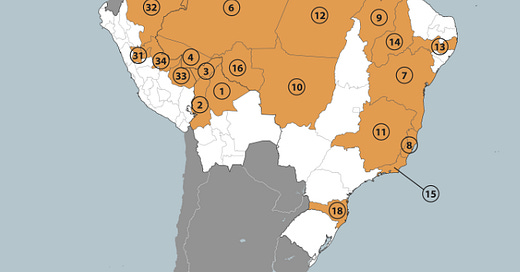The São Paulo Health Department has reported five cases of Oropouche Fever since Thursday. All five cases are registered in the Ribeira Valley region.
Four of the cases were reported from the city of Cajati while the other was in a resident of Pariquera-Açu.
In the case of the patients from Cajati, the tests were carried out in April of this year on three women and one man aged between 36 and 54. The diagnosis of Oropouche Fever was made after the results of an RT-PCR test carried out by the Adolfo Lutz Institute. The results of the disease, however, were only released this week.
According to the Cajati Municipal Health Department, all of these patients live in a rural area near a banana plantation and had no history of traveling to another city in the last 30 days. This indicates that the cases are autochthonous, that is, they were contracted in the city itself or in the place where they live.
By the beginning of July, more than 7,000 Oropouche cases had been confirmed in the country, with autochthonous transmission in at least 16 federative units.
Transmission occurs mainly through the vector Culicoides paraensis, a species of midge found from the northern United States to Argentina.
In the wild, sloths and non-human primates (and possibly wild birds and rodents) act as hosts.
The symptoms of Oropouche fever, according to the ministry, are similar to those of dengue fever and include severe headache, muscle pain, nausea and diarrhea. “In this sense, it is important that health surveillance professionals are able to differentiate these diseases through clinical, epidemiological and laboratory aspects and guide prevention and control actions,” warns the ministry.
Subscribe to Outbreak News TV on YouTube
The acute clinical picture, according to the folder, evolves with sudden onset of fever, headache, myalgia (muscle pain) and arthralgia (joint pain). Other symptoms such as dizziness, retro-ocular pain, chills, photophobia, nausea and vomiting are also reported. Cases with central nervous system involvement (such as aseptic meningitis and meningoencephalitis), especially in immunocompromised patients, and with hemorrhagic manifestations (petechiae, epistaxis, gingival bleeding) may occur.
According to the ministry, some patients (studies report up to 60%) may experience relapse, with the same symptoms or just fever, headache and myalgia after one or two weeks from the initial symptoms. “The symptoms last from two to seven days, with benign progression and no sequelae, even in the most severe cases.”
On July 25, Bahia confirmed two deaths from Oropouche fever in the state. Until then, there had been no records of deaths associated with the infection anywhere in the world.
According to the Bahia State Health Department, the deaths were recorded in patients without comorbidities and who were not pregnant. The first death, a 24-year-old woman who lived in the municipality of Valença, occurred on March 27. The second death, a 21-year-old woman who lived in Camamu, was recorded on May 10.
Health surveillance technicians from Bahia reported that the patients presented with an abrupt onset of fever, headache, retro-orbital pain and myalgia, which quickly evolved into severe symptoms, including intense abdominal pain, bleeding and hypotension.
In addition, last month, the ministry published two technical notes aimed at state and municipal managers regarding Oropouche fever. One of them recommends intensifying case surveillance and warns of the possibility of vertical transmission of the disease, which occurs when the virus is transmitted from mother to baby during pregnancy or childbirth.






